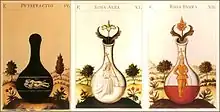
Rubedo is a Latin word meaning "redness" that was adopted by alchemists to define the fourth and final major stage in their magnum opus.[1] Both gold and the philosopher's stone were associated with the color red, as rubedo signaled alchemical success, and the end of the great work.[2] Rubedo is also known by the Greek word iosis.
Interpretation
The three alchemical stages preceding rubedo were nigredo (blackness), which represented putrefaction and spiritual death; albedo (whiteness), which represented purification; and citrinitas (yellowness), the solar dawn or awakening.[3] Some sources describe the alchemical process as three-phased with citrinitas serving as mere extension and takes place between albedo and rubedo.[4] The rubedo stage entails the attempt of the alchemist to integrate the psychospiritual outcomes of the process into a coherent sense of self before its re-entry to the world.[5] The stage can take some time or years to complete due to the required synthesis and substantiation of insights and experiences.[5]
The symbols used in alchemical writing and art to represent this red stage can include blood, a phoenix, a rose, a crowned king, or a figure wearing red clothes. Countless sources mention a reddening process; the seventeenth dictum of the 12th century Turba Philosophorum is one example:
O Turba of Philosophers and disciples, now hast thou spoken about making into white, but it yet remains to treat concerning the reddening! Know, all ye seekers after this Art, that unless ye whiten, ye cannot make red, because the two natures are nothing other than red and white. Whiten, therefore, the red, and redden the white![6]
Psychology
In the framework of psychological development (especially with followers of Jungian psychology), these four alchemical steps are viewed as analogous to the process of attaining individuation or the process that allows an individual to attain the integration of opposites, their transcendence, and, finally, emergence out of an undifferentiated unconscious.[7] In an archetypal schema, rubedo represents the Self archetype, and is the culmination of the four stages, the merging of ego and Self.[8] It is also described as a stage that gives birth to a new personality.[9] Represented by the color of blood in alchemy, the stage indicates a process that cannot be reversed since it involves the struggle of the self towards its manifestation.[10]
The Self manifests itself in "wholeness," a point in which a person discovers their true nature. Another interpretation phrased it as "reunification" which entail the reunion of body, soul, and spirit, leading to a diminished inner conflict.[11]
See also
References
- ↑ Mantello, Frank Anthony Carl; Rigg, A. G. (1996). Medieval Latin: An Introduction and Bibliographical Guide. Washington, D.C.: Catholic University of America Press. p. 413. ISBN 0813208416.
- ↑ Shaeffer, Katherine H. Stages of Transmutation: The Visual Rhetoric of Alchemy in Sequential Art.University of Florida. 2009. p.21
- ↑ M.-L. Von Franz, Alchemy (1980) p. 83
- ↑ Bogdan, Henrik (2012-02-01). Western Esotericism and Rituals of Initiation. New York: SUNY Press. p. 197. ISBN 978-0-7914-8010-6.
- 1 2 Hamilton, Nigel (2018). Awakening Through Dreams: The Journey Through the Inner Landscape. Oxon: Routledge. p. 125. ISBN 9781782200505.
- ↑ 'Turba Philosophorum. A.E.Waite translation.
- ↑ O'Connor, Peter (2014-07-17). Understanding Jung Understanding Yourself (RLE: Jung). Routledge. ISBN 9781317654278.
- ↑ Thea Euryhaessa, Running into Myself (2010) p. 278
- ↑ Mathers, Dale (2014). Alchemy and Psychotherapy: Post-Jungian Perspectives. New York: Routledge. p. 251. ISBN 9780415682039.
- ↑ Madden, Kathryn (2008). Dark Light of the Soul. SteinerBooks. ISBN 9781584205326.
- ↑ Williams, Ruth (2018-11-08). C. G. Jung: The Basics. Routledge. ISBN 9781317270959.
Further reading
- Jung, C. G. Psychology and Alchemy 2nd. ed. (Transl. by R. F. C. Hull)
External links